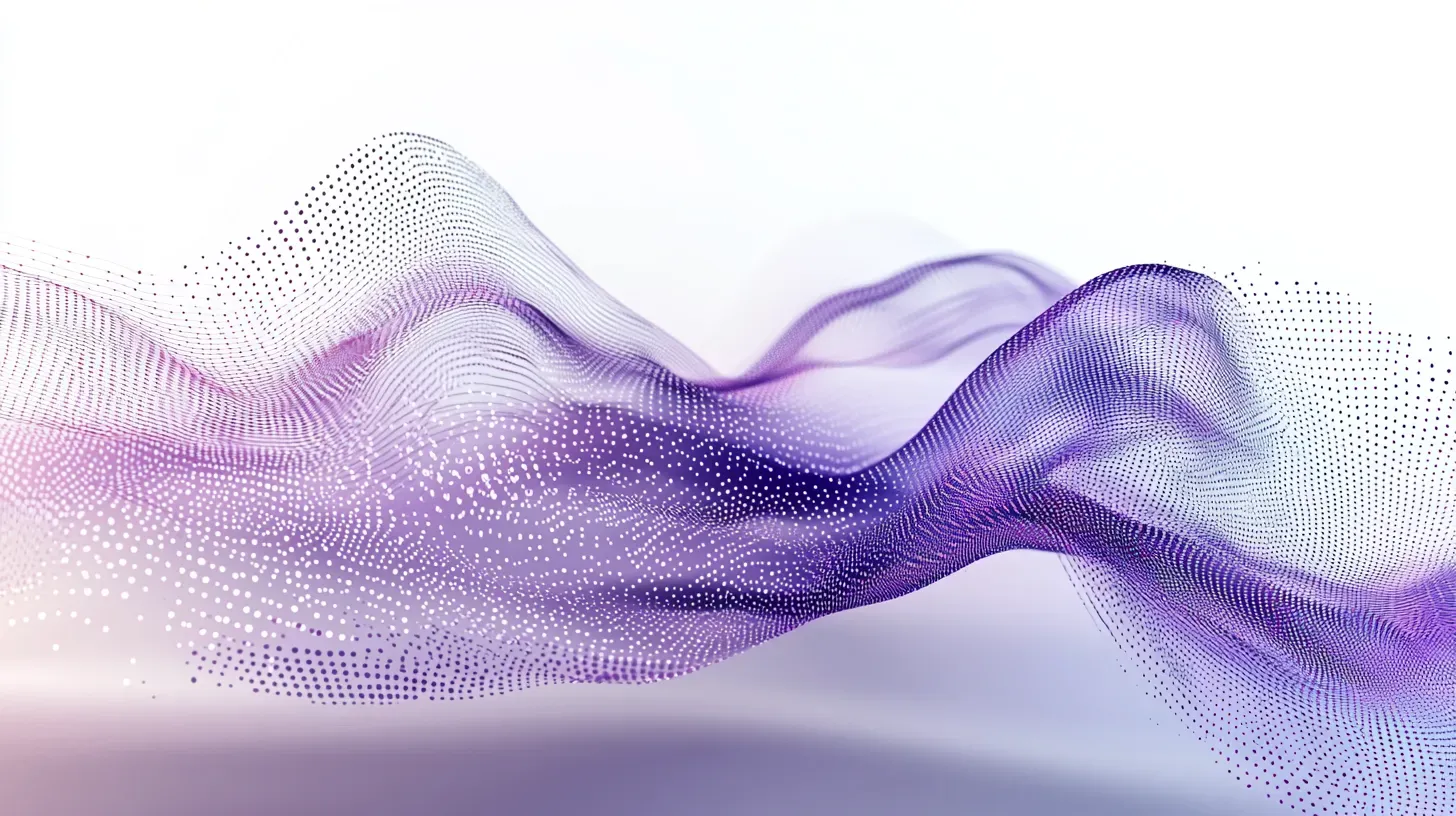The Transformative Role of AI in Revolutionising Workplace Health and Safety

The continuous advancement of technology has introduced a new era of employee welfare, with artificial intelligence (AI) playing a crucial role in safeguarding our workforce. AI has significantly impacted workplace safety through its practical applications, paving the way for a future where protection and prosperity are intrinsically linked. Through AI, businesses can enhance safety measures, identify potential hazards, and create a more secure and prosperous work environment for their employees. This technological progression promises to revolutionise workplace safety standards, ensuring a safer and more prosperous future.
Let's delve into the profound implications of AI's rise and its transformative role in ensuring workplace well-being.
The Role of AI in Workplace Health and Safety
In an ever-changing world, workplace health and safety have emerged as paramount concerns for organisations seeking to prioritise their most valuable asset - their employees. As the boundaries between human capabilities and artificial intelligence blur, the role of AI in safeguarding the workforce has become increasingly crucial. The multifaceted ways AI transforms workplace health and safety are evident by exploring its innovative applications, data-driven insights, and proactive measures. From risk assessment to accident prevention, AI's presence is reshaping how companies approach and implement health and safety practices as follows:
- Automated safety checks and predictive modelling leverage AI-driven systems for continuous monitoring, real-time responses, and standardised compliance with safety protocols, revolutionising workplace safety practices.
- Wearable devices and sensors enable real-time worker health monitoring, providing insights and enhancing workplace safety while empowering employers and employees to prioritise health and safety for increased productivity and job satisfaction.
- Human-machine collaboration is essential to balance reliance on AI and maintain human oversight, allowing human expertise to interpret complex scenarios and ensure accurate AI algorithms.
- Computer vision systems offer organisations real-time visual data analysis to proactively address safety challenges, cultivate a culture of compliance, and protect the well-being of their employees.
- Collaborative robots, or cobots, can adapt to diverse environments, making them indispensable tools for ensuring health and safety in the workplace across numerous industries.
- AI-driven training is emerging as a game-changing approach to enhancing workplace safety and many organisations are using VR training to educate employees on hazardous situations.
- Exoskeletons and assistive devices have been designed to provide physical support and assistance, reducing strain and fatigue and even enabling individuals with physical disabilities to perform tasks they previously found challenging.
Automated Checks and Predictive Modeling to Ensure Workplace Safety
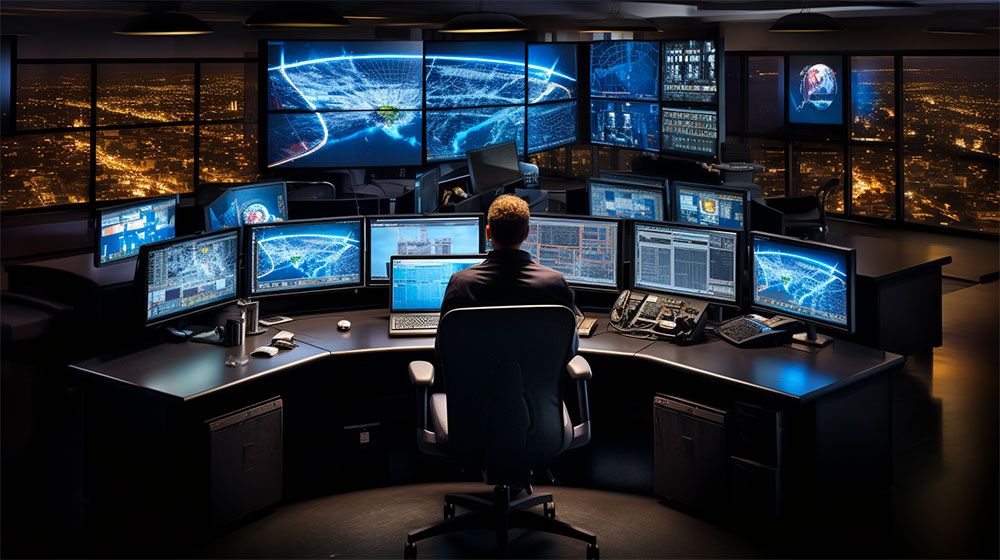
To create safer work environments, two transformative advancements have emerged: automated safety checks and predictive modelling. These cutting-edge technologies reshape traditional safety practices and empower businesses to proactively protect their workforce.
Automation has ushered in significant changes across industries, particularly in safety checks. Cumbersome manual processes have been replaced by efficient, AI-driven systems, including:
- Continuous Monitoring: Sensors, cameras, and IoT devices now vigilantly monitor workplaces, swiftly detecting potential hazards and anomalies in real time.
- Immediate Responses: With real-time data collection, organisations can respond immediately to safety concerns, minimising the risk of accidents and injuries.
- Standardised Approach: Automated safety checks ensure consistent and cohesive compliance with safety protocols across different locations and teams, fostering a culture of safety.
Predictive modelling uses sophisticated algorithms to analyse historical data and identify patterns to take workplace safety to new heights. AI systems recognise trends and correlations to anticipate potential hazards and risks, allowing organisations to implement proactive measures and protect their workforce. Also, predictive modelling aids in resource allocation, directing safety efforts to areas with higher risk probabilities.
The integration of automated safety checks and predictive modelling not only enhances employee safety but also streamlines safety procedures. Safety personnel can focus on more strategic tasks and incident response preparedness with reduced human intervention in routine checks.
General Electric (GE) has successfully integrated predictive modelling and AI-driven safety checks into their industrial operations to identify potential equipment failures and safety hazards, enabling proactive maintenance and minimising risks to their workforce.
Moreover, these data-driven insights empower organisations to continuously improve their safety strategies, fostering a culture of learning and proactive risk mitigation. With the power of automation and predictive modelling, businesses are embracing a new era of workplace safety that prioritises prevention and protection.
Wearable Devices and Sensors for Worker Health Monitoring
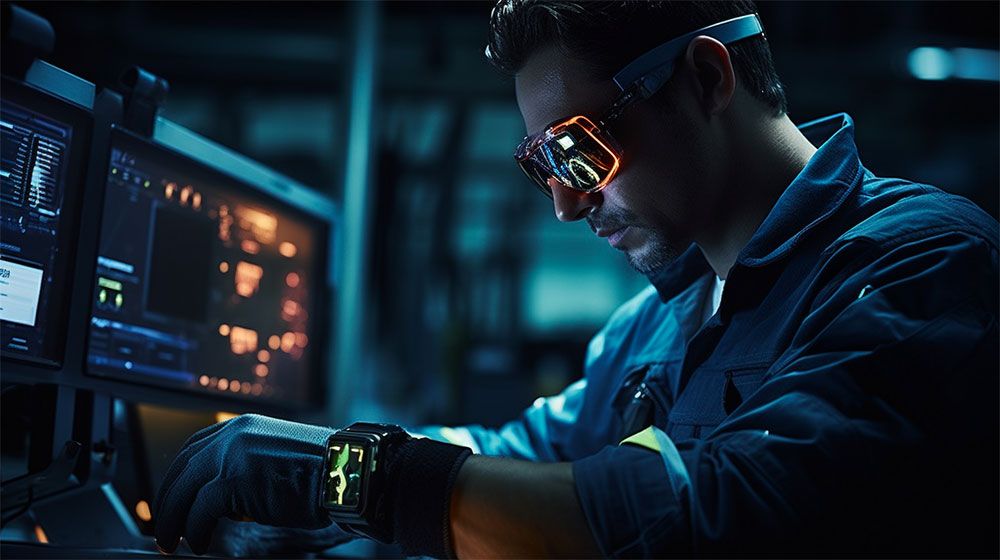
Wearables and sensors have emerged as game-changers in monitoring worker health, providing real-time insights and enhancing workplace safety offering a myriad of applications and benefits. Wearable technology examples include fitness trackers and smartwatches, which companies encourage employees to use for monitoring vital health metrics like heart rate, activity levels, and sleep patterns.
For example, Fitbit, a well-known fitness tracker, is an example of this technology that empowers workers to monitor and optimise their health in real time, gaining insights to make lifestyle adjustments based on the collected data.
Employers can use this information to identify potential health risks, such as high-stress levels or irregular sleep patterns, and implement targeted wellness programs, such as personalised fitness plans and stress management workshops, to support employee well-being.
Specialised wearable devices have become indispensable in safeguarding worker health in hazardous work environments. For instance, in construction, mining, and manufacturing industries, workers can wear smart helmets equipped with sensors to detect harmful gases, monitor environmental conditions, and even assess potential head injuries, such as the smart helmets twICEme® and MIPS. These wearables can automatically trigger alerts or emergency responses in case of accidents, ensuring timely assistance and preventing severe consequences.
Beyond wearable devices, sensor technology is also extensively used in workplace health monitoring. Environmental sensors installed throughout workspaces can detect factors like temperature, humidity, noise levels, and air quality. When combined with AI-driven systems, these sensors can assess the overall health and safety of the workplace, identifying potential hazards and proactively improving conditions for employees. OpenSensors utilises compact and affordable sensors to oversee air quality and various environmental conditions within office spaces.
Next, Johnson & Johnson has incorporated wearable health devices for their employees since 2019, enabling individuals to track their health data and engage in wellness initiatives, fostering a culture of employee well-being.
The combination of wearables and sensors empowers both employers and employees to prioritise health and safety, leading to increased productivity, reduced absenteeism, and improved overall job satisfaction. As these technologies continue to evolve, we can expect even more sophisticated and diverse applications that will undoubtedly reshape the landscape of workplace health monitoring in the years to come.
The Importance of Human-Machine Collaboration in Workplace Safety
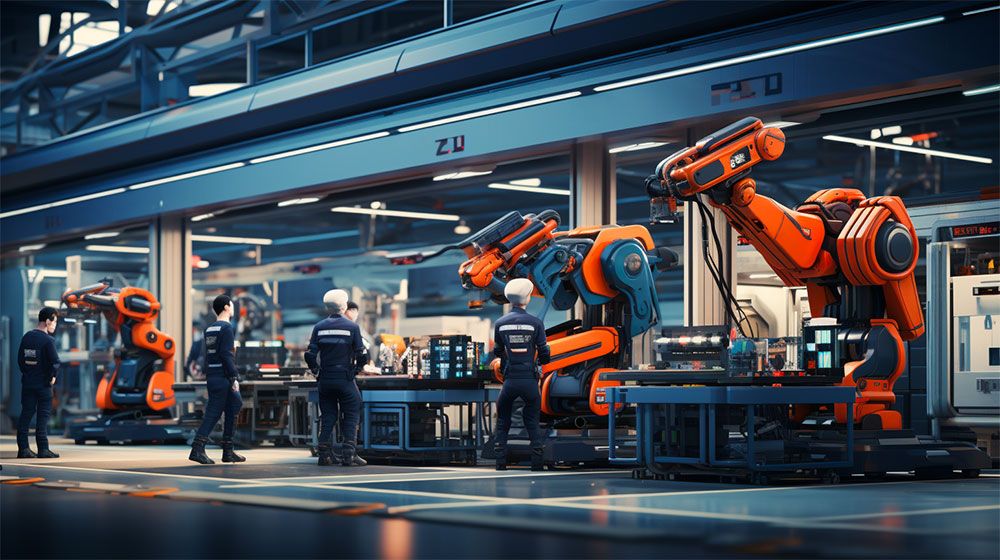
The value of AI in workplace safety cannot be overstated, as automation and predictive modelling offer tremendous advantages. However, it is equally vital to strike a balance between relying solely on AI-driven systems and maintaining human oversight. While AI can process vast amounts of data and identify patterns, human expertise remains indispensable in interpreting complex scenarios and ensuring that AI algorithms are up-to-date and accurate.
Today, human-machine collaboration emerges as a critical factor in enhancing workplace safety and well-being. Human intuition and experience can complement AI's capabilities in identifying subtle risks and understanding the broader context of safety concerns. Human operators can intervene when unexpected situations arise, providing critical decision-making capabilities that AI algorithms might not be equipped to handle.
In addition, involving employees in developing and implementing AI-driven safety measures fosters a stronger safety culture within organisations. Employees who actively contribute to the process feel more invested in the outcomes, leading to better acceptance and adherence to safety protocols.
It is also important to highlight that maintaining human oversight also addresses ethical concerns related to AI's use in the workplace. Ensuring that AI systems are programmed and regularly updated by qualified professionals helps prevent biases and ensures that the technology serves the best interests of all employees.
Computer Vision Systems for Enhanced Safety Compliance
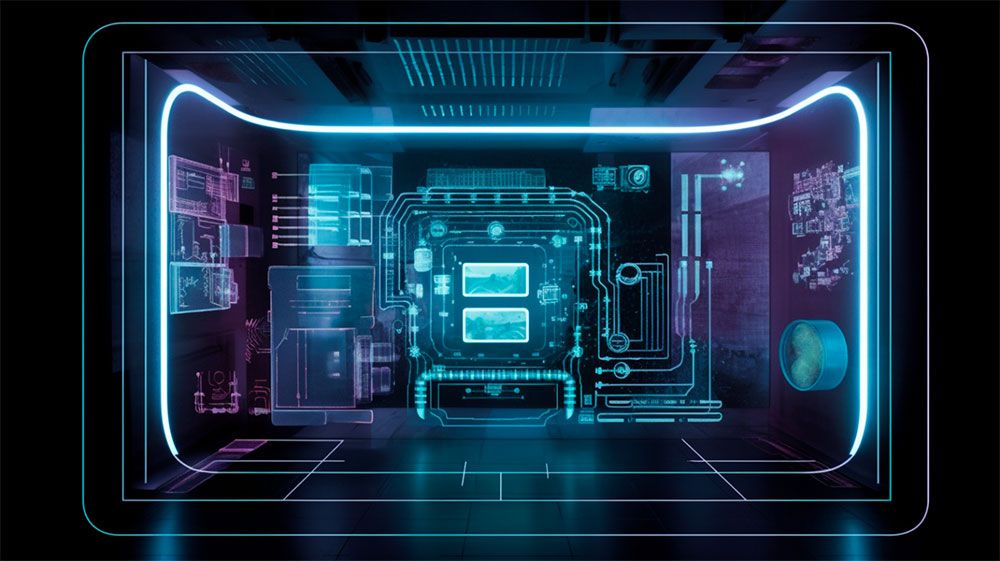
In the dynamic landscape of modern industries, ensuring the safety and well-being of workers is of utmost importance, driving organisations to uphold rigorous safety compliance standards. Computer Vision Systems are groundbreaking technology used to augment safety compliance in diverse industries while leveraging artificial intelligence and image processing to analyse visual data in real time, enabling organisations to monitor and enforce safety protocols more effectively.
A great example of Computer Vision Systems in action is in the construction industry. Ensuring compliance with safety regulations in this industry is crucial to prevent accidents and injuries. Construction companies can automatically detect potential safety hazards using cameras equipped with computer vision algorithms, such as workers not wearing protective gear or unauthorised personnel accessing restricted areas.
The system can instantly flag these incidents, enabling prompt intervention and corrective actions to maintain a safe work environment. The company Arm specialises in deploying artificial intelligence and machine learning models directly on edge devices, such as smartphones, IoT devices, or embedded systems, enabling real-time processing and decision-making at the source.
Computer Vision Systems play a vital role in ensuring worker safety and operational efficiency in manufacturing facilities. These systems can monitor the movements of employees and equipment, identifying any deviations from safe operating procedures. For instance, in a factory setting, computer vision can track workers' posture during heavy lifting tasks, alerting supervisors if they are at risk of strain or injury.
A remarkable solution offered by viso.ai is their Ergonomic Risk Analysis application. Leveraging the power of artificial intelligence and machine learning, this cutting-edge tool is designed to assess and mitigate ergonomic risks in the workplace. Viso.ai deploys AI models directly on edge devices, enabling businesses to proactively address ergonomic challenges and create healthier, safer work environments.
Retail and commercial spaces can also leverage computer vision for safety and security purposes. These systems can detect potential hazards like spills or obstacles in walkways, ensuring a safe environment for both employees and customers. Also, computer vision can aid in identifying and preventing shoplifting or unauthorised access to restricted areas, bolstering overall security measures. Edgify offers Edge AI solutions to monitor real-time Point of Sales (POS) and online shopping transactions, as well as inventory levels, promptly detecting any inconsistencies and averting stock shortages. This results in cost-effectiveness and heightened revenue generation. It also serves as a valuable tool to identify and prevent theft in retail settings, ultimately boosting profitability.
The transportation sector is no stranger to the benefits of Computer Vision Systems either. In the context of road safety, computer vision-equipped cameras can detect and alert drivers about dangerous behaviours such as distracted driving or lane drifting.
Mobileye's latest computer-vision technologies for Advanced Driver-Assistance Systems (ADAS) are empowered by more capable cameras and processors, enabling them to "see" with heightened precision, range, and breadth. Beyond the impressive hardware specifications, augmented performance and enhanced capabilities are the true value.
Driver Attention Warning, another ADAS, monitors the driver's eye and head movements for signs of drowsiness or distraction and has augmented performance and enhanced capabilities. The integration of advanced sensors and data analysis, allows this system to provide drivers with greater awareness of traffic signals, potential hazards, road conditions, and other road users. When a possible danger is detected, the driver's drowsiness and attention warning promptly alerts drivers to take immediate action. These advancements contribute to increased safety and comfort for drivers, passengers, and others sharing the road, making it an essential feature in modern vehicle safety technology.
Real-time visual data analysis can assist organisations in proactively addressing safety challenges, cultivating a culture of compliance, and protecting the well-being of their employees.
Collaborative Robots for Health and Safety in the Workplace
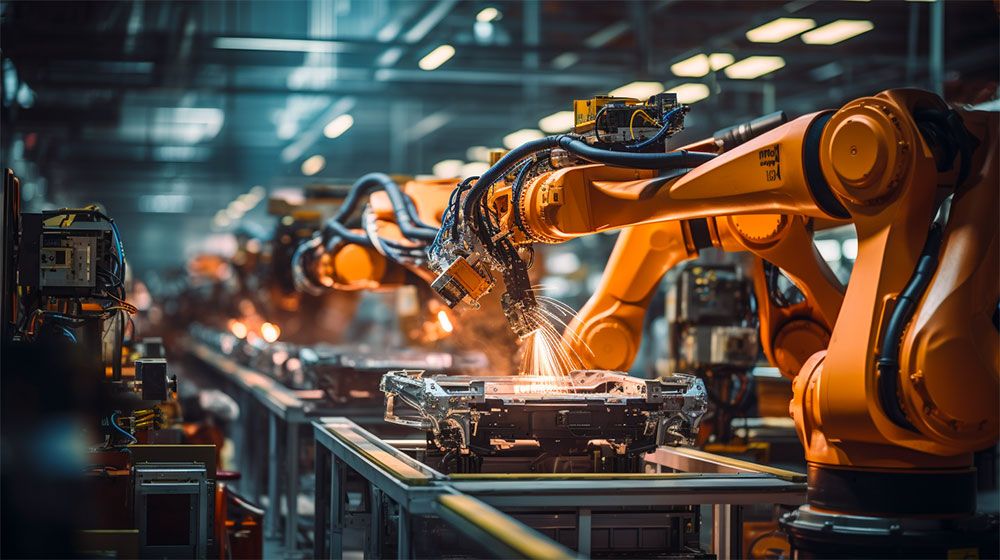
The versatility of cobots and their capacity to adapt to diverse environments make them indispensable tools for ensuring health and safety in the workplace across numerous industries. As technology evolves, their integration is expected to expand further, propelling us toward a future where human-robot collaboration becomes the norm, redefining the boundaries of what can be achieved in pursuing a safer and healthier workforce.
Usage of Cobots in Different Industries
Collaborative Robots, or cobots, have emerged as a transformative force in industries that prioritise health and safety for workers. Their ability to work alongside human operators, complementing their skills and mitigating potential hazards, has opened up innovative applications in various sectors.
Cobots play a crucial role in manufacturing and assembly lines in reducing worker fatigue and ergonomic strain. These robots can handle repetitive and physically demanding tasks, such as lifting heavy objects or assembling intricate components, thus minimising the risk of musculoskeletal injuries and enhancing overall workplace well-being. The Universal Robots UR10 cobot is an exceptional industrial robotic arm, purpose-built to tackle the most challenging tasks with unparalleled precision.
Within the construction industry, cobots are revolutionising traditional building practices. These robots are adept at bricklaying, welding, and concrete pouring, often associated with high levels of physical risk for human workers. By automating these processes, cobots create a safer work environment and significantly lower the likelihood of construction-related accidents. For instance, SAM (Semi-Automated Mason), the remarkable cobot designed by Construction Robotics, redefines bricklaying with its cutting-edge automation capabilities.
Cobots are deployed to handle dangerous materials and operations in hazardous environments, such as chemical plants or oil refineries. These robots are equipped with advanced sensors that allow them to navigate and work safely in areas where human exposure could pose health risks. In such scenarios, Cobots serve as invaluable partners in ensuring worker safety and preventing potential disasters, such as JAKA cobots, which are tailor-made to effortlessly automate repetitive tasks within the Chemical industry, excelling in palletising, inspection, picking, and packaging applications.
Cobots have streamlined material handling and inventory management processes in the logistics and warehousing sectors. SAVANT Automation has a long tradition of building Automated Guided Vehicles (AGVs) for these sectors. They collaborate with warehouse staff to optimise order picking, loading, and unloading tasks. This cooperative approach reduces the risk of accidents and improves overall operational efficiency.
AI-Driven Training for Safer Work Practices
AI-driven training is emerging as a game-changing approach to enhancing workplace safety. By leveraging artificial intelligence, organisations can develop immersive and interactive safety training programs, incorporating Virtual Reality (VR) and Augmented Reality (AR) technologies to create real-life scenarios and equip workers with the skills needed to handle potential hazards effectively.
VR and AR offer unique advantages in safety training by simulating hazardous situations without exposing trainees to actual risks. For instance, in the manufacturing industry, VR can immerse workers in a virtual factory environment, where they can safely practice operating complex machinery or handling hazardous materials. This hands-on experience enhances muscle memory and cognitive responses, preparing employees to respond confidently in real-world situations.
In fact, DHL has embraced Extended Reality (XR) technology, incorporating AR smart glasses for workflow guidance and remote support, as well as VR for training and simulation purposes. With the help of VR tools that feature live-action animation, DHL streamlines intricate tasks. As a result, workers can engage more in training, and training is more efficient and safe in logistics operations using this technology. Aside from enhancing the user experience, DHL is also exploring the emerging potential of Mixed Reality (MR), which blends virtual content with the physical world.
Companies employ AI-driven VR simulations to train workers to handle dangerous situations, like working at heights or operating heavy machinery, in a controlled and safe environment.
UPS employs VR in its driver training program to enable students to practice driving skills and learn how to identify and manage road hazards within a simulated environment. The VR simulation encompasses various scenarios, including encounters with pedestrians, parked cars, and oncoming traffic, preparing drivers for real-life challenges they may face on the road. This approach ensures that drivers gain valuable experience and are well-prepared to navigate similar situations safely and confidently during their actual driving duties.
In the oil and gas industry, these pioneering companies are using VR, AR, and MR to train their staff in hazardous situations:
- Shell: Utilises VR simulations to train employees on handling complex and hazardous scenarios, enhancing safety protocols in their oil and gas operations.
- BP: Implements VR-based training modules to simulate high-risk situations, preparing their workforce for emergencies and improving safety awareness.
- Chevron: Incorporates AR and MR technology to provide realistic virtual environments for practising emergency response procedures and safety protocols in their oil and gas facilities.
- ExxonMobil: Uses VR simulations to train workers on critical tasks and emergency procedures, promoting a safer work environment in their oil and gas operations.
- Halliburton: Implements VR training to simulate hazardous scenarios and improve the effectiveness of their workforce.
- Schlumberger- SLB: Utilises VR technology to train employees on safe practices and emergency responses in challenging environments within the oil and gas sector.
As these companies continue to leverage the power of XR technologies, they pave the way for safer operations, reduced incidents, and increased workforce competence, contributing to an overall safer and more efficient industry.
Exoskeletons and Assistive Devices for Health and Safety in Organisations
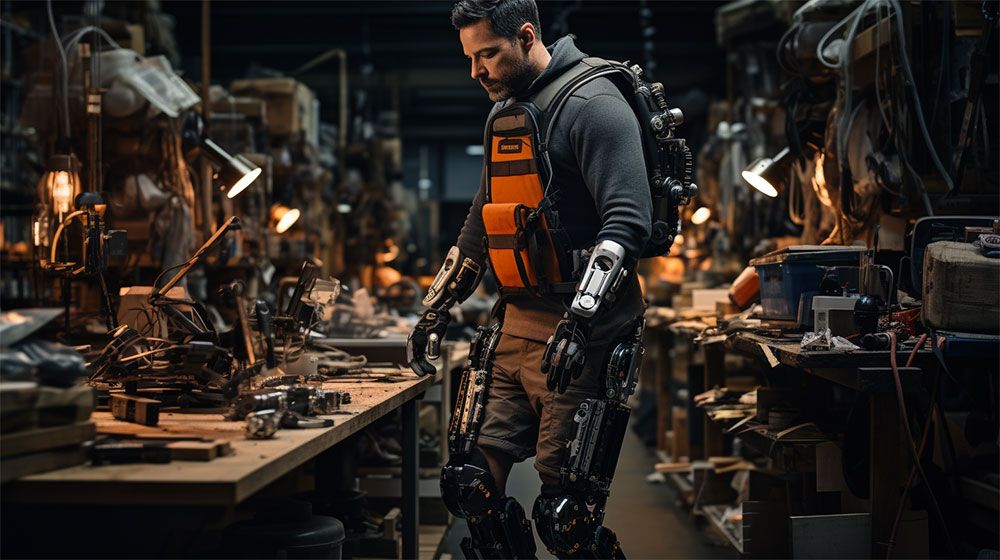
Exoskeletons and assistive devices have been designed to provide physical support and assistance, reducing strain and fatigue and even enabling individuals with physical disabilities to perform tasks they previously found challenging.
Exoskeletons are used to support workers during repetitive tasks involving heavy lifting or overhead work. These wearable devices can ease the physical burden on workers, reducing the risk of musculoskeletal injuries and improving overall productivity. For instance, workers assembling heavy machinery can wear exoskeletons to augment their strength and maintain better posture, leading to safer and more efficient work practices. Ekso Bionics is a pioneering company that develops exoskeletons and wearable assistive devices to augment human mobility and physical capabilities.
In healthcare, assistive devices like exoskeletons have been instrumental in aiding rehabilitation and mobility. Exoskeletons can assist patients with mobility impairments by providing support and guiding movements, allowing them to practice walking and regaining muscle strength. These devices have the potential to significantly improve the quality of life for individuals with mobility limitations, enabling them to participate more actively in everyday activities.
In addition, workers in distribution centres can use exoskeletons to lift and carry heavy packages, making order fulfilment more efficient and reducing the risk of injuries due to repetitive strain.
Beyond exoskeletons, other assistive devices like smart glasses are transforming workplace practices. Smart glasses with augmented reality capabilities can provide workers with real-time information and guidance during complex tasks. For example, maintenance technicians can use smart glasses to access repair manuals or receive remote assistance from experts, improving work efficiency and accuracy, such as the smart glasses developed by Vuzix.
Utilising AI Applications in High-Risk Fields
The integration of AI in the following high-risk fields exemplifies its potential to mitigate issues, create safer environments, and revolutionise how we approach challenging tasks in critical industries. Let's take a look at some of the most relevant ones:
- Predictive Maintenance in Manufacturing: AI-driven predictive maintenance systems use sensor data and machine learning algorithms to forecast equipment failures before they occur. It has the potential to identify potential issues in machinery; manufacturers can schedule maintenance proactively, reducing downtime and minimising the risk of accidents caused by faulty equipment. As a matter of fact, Siemens utilises AI-driven predictive maintenance systems in its manufacturing processes.
- Hazard Detection in Mining: AI-powered drones with advanced sensors and computer vision capabilities can survey mine sites and detect safety hazards, such as unstable terrain or toxic gas leaks. With drones to monitor remote and hazardous areas, mining companies can prioritise worker safety and respond promptly to potential threats. Barrick Gold Corporation, a leading mining company, has deployed AI-powered drones since 2012 with advanced sensors and computer vision capabilities to survey mine sites and detect safety hazards.
- AI-Enhanced Surgical Procedures: In the healthcare industry, AI is revolutionising surgical procedures by providing surgeons with real-time insights and decision support. For example, AI algorithms can analyse medical images during surgery, assisting in tumour detection, tissue analysis, and precise navigation. Artificial intelligence- and augmented reality-powered assistance help surgeons improve surgical accuracy in real-time, reduce risks, and improve outcomes for patients. Intuitive Surgical, a leader in robotic-assisted surgery, incorporates AI algorithms into its da Vinci Surgical System.
- Disaster Response and Rescue Operations: In high-risk situations, such as natural disasters or search-and-rescue operations, AI-powered drones and robots can aid first responders in assessing the situation, locating survivors, and navigating hazardous environments. These technologies enable more effective disaster response and help protect the safety of rescue teams. Klarety aims to leverage AI and emerging technologies to provide valuable insights and aid in disaster response and management, for example, in the event of a massive earthquake.
Future-Proofing Your Organisation: Adapting to AI-Driven Transformation
As businesses embark on the journey of digital transformation, embracing AI-driven solutions for workplace health and safety becomes crucial for staying competitive and resilient in a rapidly evolving landscape. Future-proofing organisations require a proactive approach that leverages AI to enhance safety protocols, improve productivity, and cultivate a culture of continuous improvement.
Roadmap for Integrating AI into Existing Health and Safety Protocols
- Assessing Current H&S Needs: Conduct a comprehensive assessment of your organisation's current health and safety practices and identify areas where AI can add value. Look for repetitive or high-risk tasks, inefficiencies in safety monitoring, and opportunities for predictive risk analysis.
- Data Collection and Preparation: Effective AI implementation relies on high-quality data. Collect and consolidate relevant data from various sources, such as incident reports, IoT sensors, and employee health records. Ensure the data is cleaned, standardised, and securely stored for AI analysis.
- Identifying AI Applications: Explore various AI applications relevant to workplace health and safety, such as predictive maintenance, real-time risk assessment, and virtual reality-based training. Tailor AI solutions to your specific industry, workplace environment, and safety challenges.
- Pilot Programs and Testing: Before fully integrating AI into existing protocols, conduct pilot programs to test the feasibility and efficacy of AI solutions. It is also important to gather feedback from frontline workers and safety experts to refine and improve AI algorithms.
- Building AI Expertise: Invest in training your workforce to understand AI and its applications in workplace health and safety. Foster a culture of continuous learning, encouraging employees to embrace AI tools and contribute to their development.
- Collaborating with AI Providers: Partner with AI solution providers and experts specialising in workplace health and safety. Collaborative efforts can help tailor AI solutions to your organisation's unique needs and ensure smooth integration.
- Establishing Clear Governance: Define roles and responsibilities for AI implementation and create governance frameworks to ensure ethical use and compliance with regulations. Transparent communication about the role of AI in safety practices builds trust and employee acceptance.
As organisations adopt AI-driven technologies for enhanced safety in the workplace, the need to protect employee privacy becomes crucial. Striking a balance between leveraging these tools and safeguarding personal information requires clear and transparent data collection policies. Organisations should prioritise data anonymisation, encryption, and regular security audits to minimise the risk of data breaches. Seeking employee consent and involvement in data privacy discussions fosters a trust culture. Staying updated on data protection regulations and seeking external audits can further ensure compliance and create a work environment prioritising safety and employee privacy.
- Monitoring and Evaluation: Implement AI-driven safety solutions with robust monitoring mechanisms to track their impact and effectiveness. Continuously evaluate the outcomes and make data-driven adjustments to optimise performance.
- Scaling Up and Continuous Improvement: Once successful AI solutions are identified, scale up their implementation across the organisation. Encourage a culture of continuous improvement, where employee feedback and AI insights are used to continually refine safety practices.
- Anticipating Future AI Advancements: Stay informed about the latest AI advancements and how they can further enhance workplace health and safety. Regularly reassess AI strategies to ensure alignment with emerging technologies and industry best practices.
Organisations can successfully integrate AI into existing health and safety protocols, improving safety outcomes and driving productivity gains. Embracing AI-driven digital transformation will position businesses to adapt, thrive, and remain resilient in the face of evolving workplace challenges.
Final Thoughts
The adoption of AI for health and safety in the workplace marks a significant shift in today's organisations. AI-driven solutions offer predictive maintenance, real-time risk assessment, virtual reality training, and wearable devices to enhance workplace safety, mitigate risks, and boost productivity. Organisations must identify safety hazards and empower workers with AI-driven insights to create a culture of prevention, fostering a collaborative work environment where technology complements human capabilities.
However, ethical considerations, data privacy, and regulatory compliance become paramount as organisations embrace AI. Striking a balance between technological innovation and respecting workers' rights is essential. Organisations must invest in workforce education, build AI expertise, and collaborate with solution providers for optimal results. With safety, transparency, and continuous improvement, organisations can unlock the full potential of AI for health and safety, ensuring safer, more productive workplaces that harmoniously integrate AI and human ingenuity.
Disclaimer: The information provided in this article is intended for general informational purposes only and does not constitute professional advice. While AI solutions can enhance workplace health and safety, it is essential to consult with local protection authorities or qualified experts to assess your organisation's specific needs and regulatory requirements. Each workplace is unique, and the implementation of AI technologies should be tailored to individual circumstances to ensure optimal safety outcomes. Always seek advice from relevant authorities and experts to make informed decisions regarding AI integration for workplace health and safety.
Images: Midjourney



